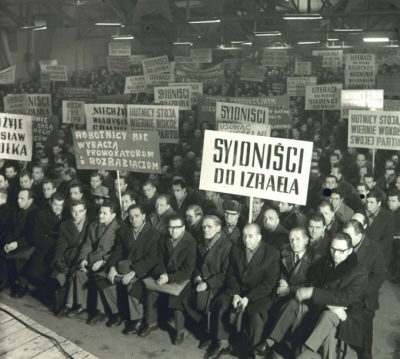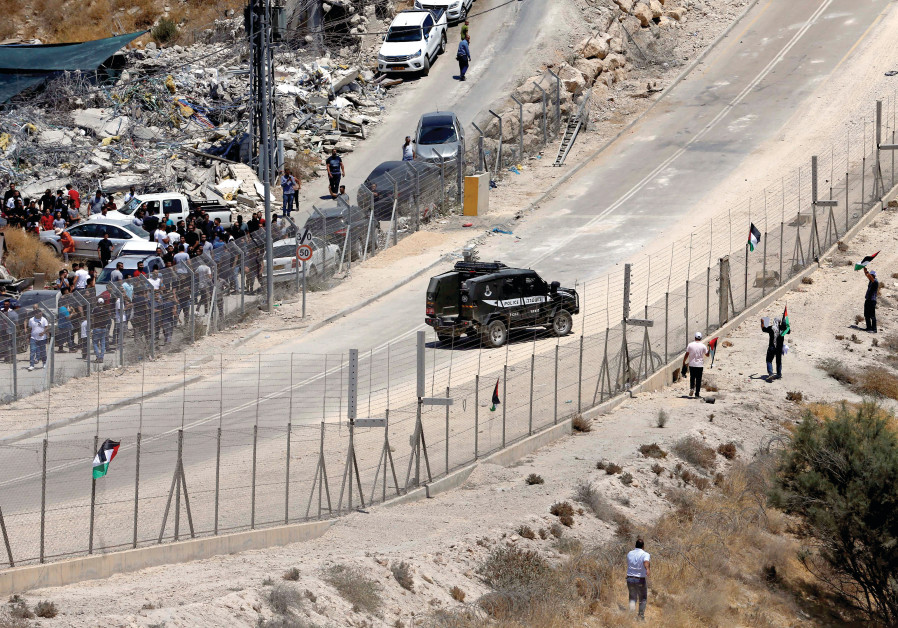 Podpalacze i zapomniany rozdział narodzin Izraela
Podpalacze i zapomniany rozdział narodzin Izraela
Andrzej Koraszewski
 Dzisiejszy zachodni antysyjonizm w Poslce był dobrze rozwinięty już w 1968 roku.
Dzisiejszy zachodni antysyjonizm w Poslce był dobrze rozwinięty już w 1968 roku.
To nie jest skarga, ale trochę czuję się zawiedziony. Piotr Ibrahim Kalwas przepowiadał, że moja książka ściągnie na mnie burzę. Tymczasem czytało ją wielu poszukiwaczy win Izraela i nic. Kilka życzliwych recenzji w Internecie, mnóstwo ogromnie sympatycznych reakcji czytelników, a burzy z piorunami jak nie było, tak nie ma. Może ci, do których ta książka była głównie adresowana, w duchu się ze mną zgadzają i tylko dla chleba powielają niesprawdzone i krzywdzące plotki o Izraelu, bo redakcje niczego innego nie chcą, a może jest jeszcze inaczej. Kto to może wiedzieć.
Moja książka żyje swoim życiem, ja swoim, nadal przyglądając się zdumiewającemu zjawisku bulgoczącej nienawiści skłaniającej porządnych (w wolnych chwilach) ludzi do przekazywania paranoicznego obrazu wszystkiemu winnych Żydów.
Niby ostatnie dwa tysiąclecia powinny nas przyzwyczaić, że kłamstwa o Żydach są integralną częścią chrześcijaństwa, a potem islamu, a potem ideologii świeckich takich jak nazizm, czy (w nowej wersji już jako antysyjonizm), radzieckiego internacjonalizmu walczącego z imperializmem, kolonializmem i o wyzwolenie narodów istniejących i nieistniejących.
Radziecki antysyjonizm przetrwał upadek radzieckiego imperium, kwitnie dziś w Ameryce, w Europie, żywy jest w Palestynie, której „prezydent” jako moskiewski doktorant pisał dysertację o kłamstwie Holocaustu. Jego współwyznawca z ISIS, francuski muzułmanin, Rachid Kassim, idzie nieco dalej niż doktor Abbas i w filmie opublikowanym 15 września stwierdza stanowczo, że Hitler był szlachetniejszy niż jakikolwiek Żyd, nie było żadnych obozów zagłady, że to wszystko są żydowskie sztuczki filmowe, a w całych Niemczech mieszkało przed wojną nie więcej jak 10 tysięcy Żydów, więc nie wiadomo skąd się te 6 milionów wzięło. Żydzi nie tylko od początku do końca wymyślili Zagładę, ale robią Palestyńczykom dokładnie to co twierdzą, że Niemcy robili im.
Można by powiedzieć, że tu paranoja jest posunięta tak daleko, iż trudno się dziwić poważnym mediom, że o tym nie donoszą, gdyby nie fakt, że film francuskiego bojówkarza Państwa Islamskiego to jeden z dziesiątków tysięcy podobnych głosów, a taką wrzawę wypadałoby już zauważyć. 16 listopada, w reakcji na wybór Trumpa, palestyński duchowny mówił w meczecie Al-Aksa, że pora zrzucić władców krajów muzułmańskich, zabrać im armie i broń i użyć pakistańskich bomb atomowych do zniszczenia Izraela. Poszukiwacze win Izraela znów odpowiedzą, że to taka pusta retoryka i nie ma o czym donosić.
„Washington Post” informował kilka tygodni temu w artykule pod tytułem In the safe spaces on campus, no Jews allowed, o atmosferze wściekłego antysemityzmu na amerykańskich kampusach uniwersyteckich. Autor, Anthony Berteaux, przywołuje relację ze studenckiej konferencji studentki z rodziny irańskich Żydów:
„W ciągu prawdopodobnie mniej niż godziny, zaprzeczono mojej historii, usprawiedliwiono mordowanie moich ludzi i gloryfikowano ruch, którego jedynym celem jest zniszczenie mojej żydowskiej ojczyzny. W wypowiedziach usprawiedliwiano brutalne mordowanie niewinnych cywilów izraelskich, jawnie zaprzeczano żydowskim związkom z tą ziemią i zaprzeczano Holocaustowi, w którym zamordowano sześć milionów Żydów. Dlaczego ktokolwiek o zdrowych zmysłach miałby akceptować te oszczerstwa, jest dla mnie nie do pojęcia. Ale oni to robili. Te wypowiedzi i inne spotkały się z niekończącymi się oklaskami i wiwatami.”
Takich relacji można przeczytać setki i właściwie trudno się temu dziwić, bo niby skąd amerykańscy studenci mają wiedzieć, że wiadomości o Izraelu w prasie i w telewizji są częściej mocno nieścisłe niż ścisłe, że dziennikarze powielają starą radziecką propagandę zapewniając, że antysyjonizm to nie antysemityzm, że media rzetelnie informują o różnych rezolucjach takich jak rezolucja UNESCO, przekreślająca związki Żydów z Jerozolimą (nie siląc się na rzetelność w relacjonowaniu tła takich rezolucji), dlaczego studenci mają sądzić, że jest coś niewłaściwego w popieraniu organizacji terrorystycznych, których celem jest mordowanie Żydów i likwidacja Izraela, jeśli ich rządy obficie finansują te organizacje, a politycy z ramienia demokratycznych partii otwarcie wyrażają dla nich poparcie?
Tak więc burzy z piorunami po książce pokazującej absurdalne wykoślawianie obrazu Izraela w mediach nie będzie z prostego powodu, że marcowe hasła są dziś powszechnie przyjęte, nawet tam, gdzie powinno to wywoływać największe zdumienie.
W tym tysiącleciu radosne przyzwolenie na mordowanie Żydów i nawoływanie do mordowania Żydów pod hasłem „antysyjonizm nie antysemityzm” gwałtownie się nasiliło. Wyszukiwanie win Izraela, które mogłyby uzasadnić to przyzwolenie, jest coraz bardziej intratne, zaś ujawnianie nieścisłości, jawnych przekłamań, trendów i zapomnianych rozdziałów historii nie należy do dobrego tonu.
Szukając dziur w tym, co z maniackim uporem prezentowane jest jako całe, nie czuję się specjalnie osamotniony, zgoła przeciwnie, nie ma dnia, żebym nie znajdował fascynujących materiałów, którymi mam ochotę podzielić się z czytelnikami.
Mitchell Bard, amerykański badacz i autor wielu znakomitych książek, przypomniał niedawno interesujące przemówienie amerykańskiego kongresmana, Johna Williama McCormacka (1891-1980) z 6 lipca 1939 roku. Zaledwie na kilka tygodni przed wybuchem drugiej wojny światowej i prawie dziesięć lat przed powstaniem Izraela, amerykański polityk mówił o faktach, o których inni woleli milczeć.
McCormack (Demokrata) mówił o “Domu Żydów w Palestynie”, a szczególną uwagę koncentrował na brytyjskiej Białej Księdze z 1939 roku, która ograniczała żydowską imigrację do Palestyny.
Przypominając, że Deklaracja Balfoura nie miała na celu utworzenia kolejnego getta dla Żydów, McCormack przywołał słowa prezydenta Wilsona z 5 marca 1919 roku, kiedy to prezydent Stanów Zjednoczonych oświadczył, że „sojusznicze narody z pełnym poparciem rządu USA, zgodziły się, iż Palestyna będzie kolebką żydowskiej wspólnoty”.
Przypomniał, że żydowska populacja w Palestynie liczyła w 1918 roku 55 tysięcy mieszkańców i wzrosła przez 20 lat do 450 tysięcy. Populacja arabska na tych terenach, od 1920 roku wzrosła z 400 tysięcy do 950 tysięcy. Wcześniej, przez stulecia tureckiego panowania była praktycznie rzecz biorąc stała, nie osiągając 300 tysięcy.
Wynika z tego – mówił John William McCormack – że przy braku jakichkolwiek ograniczeń arabskiej imigracji Żydowski Dom Narodowy będzie wkrótce zalany przez ludność nieżydowską, a Żydzi znajdą się w pułapce obietnic, zmieniając się w stale malejącą mniejszość i, podobnie jak w Europie, będą na łasce i niełasce wrogiej większości.
Kongresman podkreślał, że ta polityka naraża nie tylko projekt Domu Żydów, ale stanowi zagrożenie dla innych mniejszości, a przede wszystkim dla chrześcijan. Przypomniał masowe mordy Asyryjczyków w Iraku, którzy stanowili tam resztkę potomków rdzennej ludności Mezopotamii. Przez stulecia straszliwie cierpieli za swoją religię, ale dopiero po ustanowieniu niepodległego Iraku zaczęła się ich masowa eksterminacja.
Kongresman zauważył, że nawet obecność Brytyjczyków nie gwarantuje bezpieczeństwa Żydów w Palestynie, że Brytyjczycy byli nadal obecni w Iraku, ale nie byli w stanie powstrzymać masakry Asyryjczyków.
„Jeśli świat nie robi sobie kpin z obietnicy dla żydowskiego narodu, akceptowanej przez 52 państwa stanowiące większość świata, to najmniejsze co możemy zrobić to zezwolenie na budowanie Narodowego Domu Żydowskiego w Palestynie zgodnie z wyraźnymi założeniami mandatu.”
W lipcu 1939 roku było to stanowisko niesłychanie odosobnione i całkowicie sprzeczne z brytyjską polityką w Mandacie Palestyńskim. McCormack mówił o całkowicie absurdalnym argumencie Brytyjczyków na temat ograniczonych możliwości absorbcji żydowskich imigrantów w Palestynie.
“Jednym z argumentów na rzecz ograniczenia żydowskiej imigracji do Palestyny jest twierdzenie, że kraj jest już przeludniony. To był główny akcent raportu, który przedstawił Sir Hope Simpson jeszcze w roku 1930. Rząd brytyjski odrzucił wówczas ten raport i jak się okazało to odrzucenie było uzasadnione, ponieważ od tamtego czasu przybyło 150 tysięcy Żydów i tyleż samo Arabów i nadal są tam duże obszary wolnej ziemi, którą można wykorzystać na rozwój osadnictwa dla dużej populacji.”
W Europie obozów masowej zagłady jeszcze nie było, znano już Mein Kampf, była już noc kryształowa, dziwowano się tu i ówdzie nad publikacjami „Der Stürmera”. W lipcu 1939 roku amerykański polityk mówił:
„Na konferencji pokojowej przedstawiono informacje, że w Libanie, którego warunki są podobne do Palestyny, jest 160 mieszkańców na kilometr kwadratowy. W Palestynie jest tylko 50 osób na kilometr kwadratowy. Na tej podstawie można powiedzieć, że w Palestynie jest miejsce na dalsze 3 miliony ludzi bez naruszania uprawnionych interesów ludzi, którzy tam już mieszkają.[…]
Wynika z tego, że jest całkowicie możliwe zaabsorbowanie w ciągu roku 100 tysięcy uchodźców, którym, jak twierdzi Żydowska Agencja do spraw Palestyny, można zapewnić akomodację oraz 10 tysięcy dzieci, dla których domy są już przygotowane.”
Mimo oficjalnego poparcia Stanów Zjednoczonych dla idei Domu Żydów naciski na Wielką Brytanię nie były zbyt silne. Wielka Brytania dała niepodległość i zakończyła swój mandat w Iraku, wydzieliła ponad 70 procent Palestyny na Transjordanię (dziś Jordanię), otworzyła na oścież drzwi dla Arabów chcących wjechać na pozostałe tereny Palestyny, a wreszcie uzbroiła i zaopatrzyła w kadry dowódcze Legion Arabski, który wspólnie z Egiptem i innym państwami arabskimi szykował się do ostatecznego rozwiązania kwestii żydowskiej. Napaść pięciu armii arabskich w dniu ogłoszenia niepodległości Izraela nie była dla nikogo zaskoczeniem. Zaskoczeniem było przetrwanie żydowskiej populacji w Palestynie i skuteczna obrona kraju. Aneksja Judei i Samarii oraz Wschodniej Jerozolimy przez Jordanię nie budziła niczyich protestów, chociaż tylko Wielka Brytania uznała ją formalnie. Odbicie tych ziem w 1967 roku do dziś nazywane jest okupacją.
Wojna 1948 roku spowodowała exodus ludności palestyńskiej. 700 do 800 tysięcy arabskich mieszkańców z terenów dzisiejszego Izraela albo posłuchało wezwań przywódców arabskich, by ewakuowali się na czas wojny (która w ich zapowiedziach miała trwać nie dłużej niż tydzień), albo (jeśli byli aktywnie zaangażowani w walki z żydowskimi sąsiadami) zostali wygnani. W efekcie arabska ludność Izraela zmniejszyła się do 156 tysięcy. W kolejnych latach blisko 800 tysięcy Żydów napłynęło z krajów arabskich. Jednak tylko „Palestyńczycy” pozostają uchodźcami również w trzeciej i czwartej generacji.
(Piszę Palestyńczycy w cudzysłowie, bo decyzją UNRWA uchodźcą palestyńskim zostawało się po oświadczeniu, że mieszkało się dwa lata na terenie pozostałości Mandatu Palestyńskiego po utworzeniu Transjordanii.) Głośne mówienie dziś, że istnieje państwo Arabów palestyńskich i że jest nim Jordania, wywołuje pełne zdumienia oburzenie (a mówi to m. in. przywódca jordańskich Palestyńczyków Mudar Zahran), mówienie o Judei i Samarii wywołuje oburzenie, bo Jordania nazwała ten obszar swoją prowincją na Zachodnim Brzegu rzeki Jordan, pokazywanie, że przywódcy Autonomii Palestyńskiej odmawiają rozmów pokojowych i pokojowego współżycia z Izraelem, wywołuje oburzenie, bo wszystko jest przecież winą Izraela.
Od dwóch dni w Izraelu szaleją pożary i arabska publiczność już nazwała to „intifadą pożarów” (nie ma wątpliwości, że większość tych pożarów to podpalenia). Radość Arabów udziela się z jakiegoś powodu wielu Amerykanom i Europejczykom, więc pod doniesieniem o koszmarze podpaleń również na polskiej stronie pojawiły się radosne komentarze w stylu:
– jak to było w ‘Lalce’ Icka fabryka się pali.. czyli bankrutują 🙂 jakoś tak.. stara żydowska metoda na bankructwo i wyciąganie kasy z ubezpieczeń od pożarów.
– Pan Bóg nierychliwy ale sprawiedliwy
– jest mi z tego powodu strasznie wszystko jedno
– Jak sie burzy domy Palestynczykom, demoluje sie im infrastrukture, niszczy zbiory to nie należy sie spodziewać róż.
– Za Hitlera wszystkiemu byli winni żydzi Teraz wszystkiemu winni są Palestyńczycy. W sumie niewiele się zmieniło.
Mało prawdopodobne, aby doniesienie o katastrofie (nie mówiąc o umyślnych podpaleniach) w jakimkolwiek innym kraju wywołało tak ciepłe reakcje czytającej publiczności. Podejrzewam, że nie jest to tylko efekt wielowiekowej tradycji. Licząca zaledwie pół wieku tradycja radzieckiej propagandy jest bardzo dzielnie podtrzymywana, również przez tych, którzy kiedyś biegali na „Dziady”.
Czekanie na burzę z piorunami po mojej książce wydaje się być czekaniem na Godota. Próby odkłamywania kompletnie przekłamanego obrazu zakrawają na zawracanie Wisły kijem, zauważą co robisz zainteresowani, agitatorzy zignorują, potencjalni czytelnicy, otwarci na fakty i argumenty, nigdy się nie dowiedzą.



